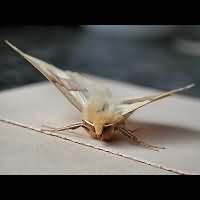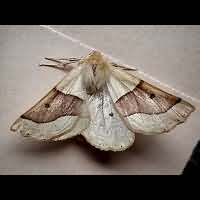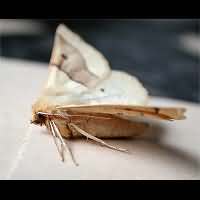Scalloped Oak (Crocallis elinguaria)
The Scalloped Oak has a remarkable resting posture. The wings are held straight horizontally. Not pointed upwards, like the Thorns, and not flat on the surface, like in most other Geometers. The wings are usually coloured in just one basic colour, with a broad, darker band running over it. In the band a very conspicuous black dot is visible. The colours do vary however and in dark animals, the band may hard to see. And from time to time the band is of a lighter colour then the rest of the wing is. The dot however is always there. It looks like the Scalloped Hazel a lot, but the later has no dot, but a small open circle, and clearer, dented lines around the band. The wingspan is some 40 to 46 mm.
The eggs are being deposited in August or September. They only hatch next spring. The caterpillar of the Scalloped Oak is very variable. It may be greyish green. These animals are extremely hard to find on lichen clad trees. Others are dark brown. These are well camouflaged among twigs. Brown larvae often have a diamond shaped pattern on the back. There is a bump on the 11th segment and the caterpillar's head is brown. The larva isn't very fat, but quite long, reaching a length of some 43 mm. The caterpillar lives on a great number of trees and shrubs, except for conifers. There hardly seems to be a favourite among them. They drop to the ground in June and pupate between leaves or under mosses.
The Scalloped Oak is on the wing in late summer, but the exact period is hard to say. Apparently the flying period depends on the weather. In some years it will be on the wing in July and August mainly, but in others it doesn't start flying before August and is on the wing in September as well. Some animals may fly in October as well. It flies by night only and is rarely seen doing so. During daytime it may be found resting on tree trunks or fences. Luckily it comes to light quite readily, sometimes in great numbers. A common species in most of Britain, including some of the Hebrides. In France, Spain, Portugal and some Mediterranean Isles there is a very similar species called the Dusky Scalloped Oak. This species made it to Guernsey. Usually it is enough to look at the numerous small dots to tell it apart from the Scalloped Oak.
The Scalloped Oak has a remarkable resting posture. The wings are held straight horizontally. Not pointed upwards, like the Thorns, and not flat on the surface, like in most other Geometers. The wings are usually coloured in just one basic colour, with a broad, darker band running over it. In the band a very conspicuous black dot is visible. The colours do vary however and in dark animals, the band may hard to see. And from time to time the band is of a lighter colour then the rest of the wing is. The dot however is always there. It looks like the Scalloped Hazel a lot, but the later has no dot, but a small open circle, and clearer, dented lines around the band. The wingspan is some 40 to 46 mm.
The eggs are being deposited in August or September. They only hatch next spring. The caterpillar of the Scalloped Oak is very variable. It may be greyish green. These animals are extremely hard to find on lichen clad trees. Others are dark brown. These are well camouflaged among twigs. Brown larvae often have a diamond shaped pattern on the back. There is a bump on the 11th segment and the caterpillar's head is brown. The larva isn't very fat, but quite long, reaching a length of some 43 mm. The caterpillar lives on a great number of trees and shrubs, except for conifers. There hardly seems to be a favourite among them. They drop to the ground in June and pupate between leaves or under mosses.
The Scalloped Oak is on the wing in late summer, but the exact period is hard to say. Apparently the flying period depends on the weather. In some years it will be on the wing in July and August mainly, but in others it doesn't start flying before August and is on the wing in September as well. Some animals may fly in October as well. It flies by night only and is rarely seen doing so. During daytime it may be found resting on tree trunks or fences. Luckily it comes to light quite readily, sometimes in great numbers. A common species in most of Britain, including some of the Hebrides. In France, Spain, Portugal and some Mediterranean Isles there is a very similar species called the Dusky Scalloped Oak. This species made it to Guernsey. Usually it is enough to look at the numerous small dots to tell it apart from the Scalloped Oak.








